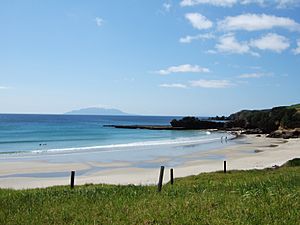Tāwharanui Peninsula facts for kids
Tāwharanui Peninsula is a piece of land that sticks out into the Hauraki Gulf on the east coast of New Zealand's larger North Auckland Peninsula. It separates Omaha Bay to the north from Kawau Bay and Kawau Island to the south. The closest big town is Warkworth.
The Tāwharanui Regional Park covers 588 hectares of the peninsula's land. The Tāwharanui Marine Reserve protects the sea along the northern coast. Both are managed by Auckland Council, which also owns the regional park.
The land itself is made of Waitemata Sandstone on top of older, folded rock called greywacke.
Contents
A Look at Tāwharanui's Past
Māori people lived in this area for more than 800 years. The name Tāwhara-nui means "the many bracts of the kiekie vine."
Until the 1870s, a small group of the Te Kawerau people, called Ngati Raupo, lived here. They mostly lived near the Mangatawhiri Stream. A very important fortified village, called a pā, named Oponui, was near the park's entrance. Another pā, Pa-hi, meaning "lofty fortified settlement," was above the stream's outlet.
Tāwharanui offered a lot of food and resources from both the sea and the forest. A famous saying about the area was: "He wha tāwhara ki uta; he kiko tamure ki tai" – meaning "The flowering bracts of the kiekie on the land, the flesh of the snapper in the sea." Waikokowai, also known as Anchor Bay, was a valuable source of kokowai or red ochre. This red ochre was used for decorating and for special ceremonies.
The Māori owners sold Tāwharanui between 1873 and 1877. After that, families like the Martins, Jones, and Youngs developed it into a farm. For many years, Kauri timber was cut down, and manuka was used for firewood. Shingle was taken from the area for a hundred years, which created the Jones Bay Lagoon.
Between 1871 and 1978, nine ships were wrecked along the Tāwharanui coast. Anchor Bay got its name from the anchor of a ship called the Phoenix, which was wrecked there in 1879. The Auckland Regional Authority, which later became the Auckland Council, bought the parkland in 1973.
Tāwharanui Regional Park: A Special Place
This park is a unique "mainland island" sanctuary. This means it's a safe place for native plants and animals, but it also has farmland and areas for people to enjoy.
Most of the park is covered in grass for grazing animals, with manuka trees scattered around and patches of coastal forest. The biggest area of coastal forest is in the central eastern part of the park. Here, you'll find tall kauri and rimu trees on the ridges. In the valleys, there are puriri, taraire, tawa, and sometimes rewarewa and nikau palms. Other trees in the park include totara, kahikatea, pohutukawa, cabbage trees, karaka, and New Zealand flax.
The "mainland island" was created in 2004 by building a 2.5-kilometer-long pest-proof fence across the peninsula. After the fence was built, a special operation removed pests like black rats, brown rats, wild cats, possums, weasels, stoats, and ferrets. Some introduced pests, like mice, rabbits, and hedgehogs, still remain in the sanctuary. The Tawharanui Open Sanctuary Society Inc. (TOSSI) is a group that helps Auckland Council by raising money and doing volunteer work for the sanctuary.
The park is home to 16 types of native land birds and 15 types of native coastal birds. You might see wetland birds like the Australasian bittern, spotless crake, and fernbird. Coastal birds include the New Zealand dotterel, blue reef heron, and variable oystercatcher.
Tāwharanui Marine Reserve: Underwater Wonders
The Tāwharanui Marine Reserve was set up in September 2011. Before this, it was the Tāwharanui Marine Park, which was New Zealand's first Marine Protected Area established in 1981.
The marine reserve covers about 400 hectares. It stretches from the high-water mark out to half a nautical mile into the sea, along three kilometers of coastline. Rules here mean you are not allowed to take any marine life from the water.
The diverse coastline has many different underwater homes for sea creatures, including reefs with overhangs, tunnels, and caves. You can often see schools of fish like red moki, blue maomao, spotty, red mullet, and koheru. The North Island brown kiwi has also been brought back to this area. Larger sea animals, called cetaceans, such as bottlenose dolphins and orcas, also visit the nearby waters.
|
See also
 In Spanish: Península de Tawharanui para niños
In Spanish: Península de Tawharanui para niños



